#Alfred jodl
Text
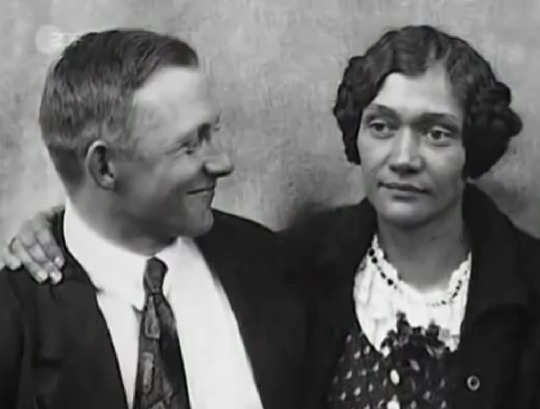
find me a man who'll look at me the way Alfred looks at Irma please😭😔💔
#look at his eyes#AND HIS SMILE#he was SO in love#you can tell that it's obvious#his Irmlein and her Fähnlein#💔#me cry#me when#alfred jodl#irma jodl#irma gräfin von bullion#heer#3rd reich#third reich#((not really actually))#wife#love#romance
2 notes
·
View notes
Photo

5 notes
·
View notes
Text
Alfred jodl

The genius of the Fuehrer and his determination not to shun even a World War have again won the victory without the use of force. Jodl conferred with the propaganda experts on "imminent common tasks" such as German violations of international law, exploitation of them by the enemy and refutations by the Germans, which "task" Jodl considered "particularly important."Īfter Munich, Jodl wrote : "Czechoslovakia as a power is out. Jodl admits he agreed with OKH that the "incident" to provide German intervention must occur at the latest by 1400 on X-1 day, the day before the attack, and said it must occur at a fixed time in good flying weather. He initialed items 14, 17, 24, 36, and 37 in the notes. In planning the attack on Czechoslovakia, Jodl was very active, according to the Schmundt notes. Jodl issued supplementary instructions on 11 March, and initialed Hitler's order for the invasion on the same date. His diary for 10 March shows Hitler then ordered the preparation of "Case Otto," and the directive was initialed by Jodl. When Hitler decided "not to tolerate" Schnschnigg's plebiscite, Jodl brought to the conference the "old draft," the existing staff plan. Though he claims that as a soldier he had to obey Hitler, he says that he often tried to obstruct certain ineasnres by delay, which occasionally proved successful as when he resisted Hitler's demand that a directive be issued to lynch allied "terror fliers."Įntries in Jodl's diary of 13 and 14 February 1938 show Hitler instructed both him and Keitel to keep up military pressure against Austria begun at the Schuschnigg conference by simulating military measures, and that these achieved their purpose. He said that when he signed or initialed orders, memoranda, and letters, he did so for Hitler and often in the absence of Keitel. In the strict military sense, Jodl was the actual planner of the war and responsible in large measure for the strategy and conduct of operations.Īt Nuermberg Jodl defended himself on the ground he mas a soldier sworn to obedience, and not a politician and that his staff and planning work left him no time for other matters. Although Keitel was his immediate superior, Jodl reported directly to Hitler on operational matters. In September 1939 he took part in the invasion of Poland. It is the same problem as in 1914." After the Anschluss he was sent to Vienna as head of the 44th Artillery Command, where for a year he was in command of troops.īeing a staunch supporter of the Nazi party, he was nominated in August 1939, to the position of Chief of the Operations Staff of the High Command of the Armed Forces Oberkommando der Wehrmacht (OKW). In my opinion it is only by action that they can now atone for their faults of lack of character and discipline. Alfred Jodl, wrote in his diary (10th August, 1938) "It is tragic that the Fuehrer should have the whole nation behind him with the single exception of the Army generals. From 1935 to 1938 he was Chief of the National Defense Section in the High Command. In 1935 Jodl was promoted to the rank of major general. Disillusioned by Germany's defeat he considered leaving the army and becoming a doctor.Ī strong supporter of the National Socialist German Workers Party (NSDAP), Jodl worked closely with Adolf Hitler. He recovered and saw further action on the Western Front and the Eastern Front. Soon after the outbreak of the Great War Jodl suffered a severe thigh wound. He attended cadet school and 1910 joined a field military regiment in the German Army. Alfred Jodl - together with Goering, Schacht, and Speer - was one of the four outstanding personalities in the dock at Nuremberg.Īlfred Jodl was born on in Wurzburg, son of a retired Bavarian artillery captain. Count Four charged the defendants with crimes against humanity. Count One charged all of the defendants with being "leaders, organizers, instigators, or accomplices in the formation or execution of a common plan or conspiracy to commit, or which involved the commission of, Crimes against Peace, War Crimes, and Crimes against Humanity." Count Two charged the defendants with crimes against peace by their participation "in the planning, preparation, initiation, and waging of wars of aggression." Count Three charged the defendants with war crimes. The International Military Tribunal trials at Nuremberg in 1946 charged the defendants with four crimes.

0 notes
Text
Alfred jodl

#ALFRED JODL TRIAL#
#ALFRED JODL PROFESSIONAL#
Subsequently, interviewed by Gitta Sereny, researching her biography of Albert Speer, Luise alleged that in many instances the Allied prosecution made charges against Jodl based on documents that they refused to share with the defence. His wife Luise attached herself to her husband's defence team. Although he denied his role in this activity of the Third Reich's rule, the court sustained his complicity based on the evidence it had examined with the French judge, Henri Donnedieu de Vabres, dissenting. Presented as evidence was his signature on an order that transferred Danish citizens, including Jews, to concentration camps.
#ALFRED JODL TRIAL#
When confronted with mass shootings of Soviet POWs in 1941, Jodl claimed the only prisoners shot were "not those that could not, but those that did not want to walk." Īdditional charges at his trial included unlawful deportation and abetting execution. The principal charges against him related to his signature of the Commando Order and the Commissar Order, both of which ordered that certain classes of prisoners of war were to be summarily executed upon capture. Jodl was accused of conspiracy to commit crimes against peace planning, initiating and waging wars of aggression war crimes and crimes against humanity. Jodl was arrested and transferred to Flensburg POW camp and later put before the International Military Tribunal at the Nuremberg trials. Jodl signs the instruments of unconditional surrender in Reims on At the end of World War II in Europe, Jodl signed the instruments of unconditional surrender on in Reims as the representative of Karl Dönitz. Jodl was among those slightly injured during the 20 July plot of 1944 against Hitler where he suffered a head concussion by the explosion planned by Claus von Stauffenberg. Jodl signed the Commissar Order of 6 June 1941 (in which Soviet political commissars were to be shot) and the Commando Order of 28 October 1942 (in which Allied commandos, including properly uniformed soldiers as well as combatants wearing civilian clothes, such as Maquis and partisans, were to be executed immediately without trial if captured behind German lines). Following the Fall of France Jodl was optimistic of Germany's success over Britain, on 30 June 1940 writing "The final German victory over England is now only a question of time." Jodl acted as a Chief of Staff during the swift occupation of Denmark and Norway. Jodl was chosen by Hitler to be Chief of Operation Staff of the newly formed OKW. In the build-up to the Second World War, Jodl was nominally assigned as a commander of the 44th Division from October 1938 to August 1939 during the Anschluss. In September 1939 Jodl first met Adolf Hitler. Jodl's appointment as a major in the operations branch of the Truppenamt in the Army High Command in the last days of the Weimar Republic put him under command of General Ludwig Beck. Jodl, between Major Wilhelm Oxenius (left) and Admiral Hans-Georg von Friedeburg (right), signing the German Instrument of Surrender at Reims, France Jodl was married twice, in 1913, and then in 1944, after becoming a widower.
#ALFRED JODL PROFESSIONAL#
After the defeat of the German Empire in 1918, he continued his career as a professional soldier with the much reduced German Army in the guise of the Reichswehr. In 1918 he was again awarded the Iron Cross for gallantry in action. In 1917 he served briefly on the Eastern Front before returning to the West as a Staff Officer. įrom 1914 to 1916 he served with a Battery unit on the Western Front, being awarded the Iron Cross for gallantry in November 1914, and being wounded in action. The philosopher and psychologist Friedrich Jodl at the University of Vienna was his uncle. Ferdinand Jodl, who also was to become a General in the Army, was his younger brother. Found guilty on all charges, he was sentenced to death and executed in 1946.Īlfred Jodl was educated at a military Cadet School in Munich, from which he graduated in 1910. The principal charges against him related to his signature of the criminal Commando and Commissar Orders.
info) – 16 October 1946) was a German general and war criminal during World War II, who served as the Chief of the Operations Staff of the Armed Forces High Command ( Oberkommando der Wehrmacht).Īfter the war, Jodl was indicted on the charges of conspiracy to commit crime against peace planning, initiating and waging wars of aggression war crimes and crimes against humanity at the Allied-organised Nuremberg Trials.
Knight's Cross of the Iron Cross with Oak LeavesĪlfred Josef Ferdinand Jodl ( listen ( help

0 notes
Photo

2 notes
·
View notes
Text

German dictator (NSDAP)in 'Wolfsschanze' military headquarters in East Prussia attending the presentation of an amphibian vehicle by Ferdinand Porsche jun., from left chauffeur Erich Kempka, SS-Officer Karl Wolff, personal adjutant SS-officer Julius Schaub, Heinrich Himmler, General Alfred Jodl- around 1941/42.
#ww2#ww2 germany#second world war#waffen ss#wwii#world war 2#1940s#world war two#world war ii#ww2 history#war history#war#officers#germany#ww2 era#wwii era#wwii germany#wars#photography#tumbler#Prussia#history
26 notes
·
View notes
Text
On This Day - 16th Oct 1946
Marks 77 years since the Nuremberg executions. (This is gonna be one of my longer posts guys).
At the Nuremberg trials, 12 Nazi war criminals were sentenced to death by hanging: Hermann Göring, Joachim von Ribbentrop, Hans Frank, Wilhelm Frick, Alfred Jodl, Ernst Kaltenbrunner, Wilhelm Keitel, Alfred Rosenberg, Fritz Sauckel, Arthur Seyss-Inquart, Julius Streicher and Martin Bormann (whom was sentenced to death in absentia - as his whereabouts at the time were unknown. It is now believed he died trying to escape Berlin in 1945).
I'll go through each of the executions in order of scheduling:
Hermann Göring.
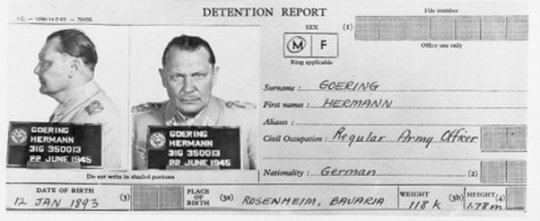
Hermann Göring was the first scheduled to be hung. However, after being denied his request to be shot by firing squad Göring committed suicide in his cell via a cyanide capsule two hours before the scheduled executions were to be carried out. It's unknown how he acquired the cyanide, as cells were checked thoroughly and regularly as well as body searches. There are some rumours however, including one that suggests that the capsule was brought to him by his wife through their departing kiss. Because of his suicide in his cell, no last words were recorded. He was aged 53.
2. Joachim von Ribbentrop
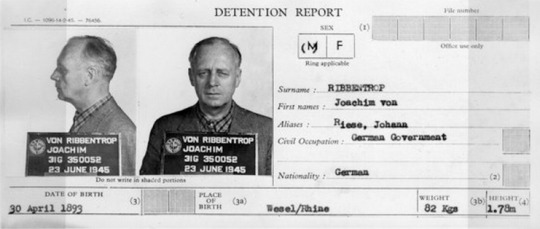
Joachim von Ribbentrop was the first to actually be executed. Upon reaching the dock his last words were: "God protect Germany. God have mercy on my soul. My final wish is that Germany should recover her unity and that, for the sake of peace, there should be an understanding between East and West. I wish peace to the world." It was later recalled that before the hood was placed over his head, he looked over at the Lutheran chaplain and said "I'll see you again." His time of death was recorded at 1:30AM. He was aged 53.
3. Wilhelm Keitel
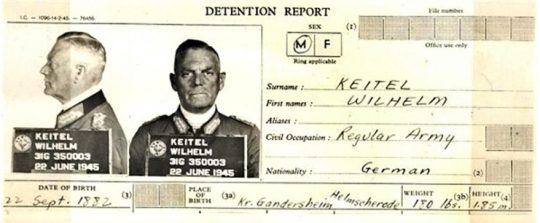
Wilhelm Keitel's last words were: "I call on God Almighty to have mercy on the German people. More than two million German soldiers went to their death for the fatherland before me. I follow now my sons - all for Germany." His time of death was recorded at 1:44AM. He was aged 64.
4. Ernst Kaltenbrunner

(couldn't find his detention report, frustratingly. So have this image instead.)
Ernst Kaltenbrunner's last words were: "I have loved my German people and my fatherland with a warm heart. I have done my duty by the laws of my people and I am sorry my people were led this time by men who were not soldiers and crimes were committed of which I had no knowledge." His time of death was recorded at 1:52AM. He was aged 43.
5. Alfred Rosenberg
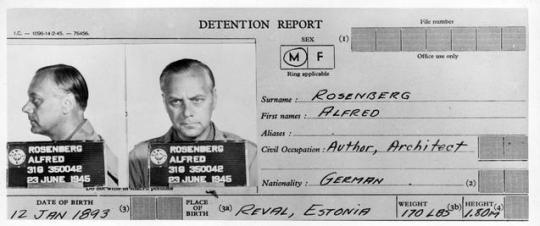
Alfred Rosenberg's last words were: "No." He was the only one who refused to make a final statement. His time of death was recorded at 1:59AM. He was aged 53.
6. Hans Frank
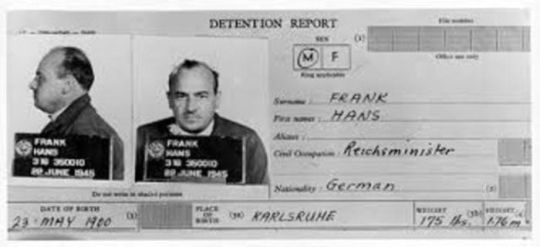
Hans Frank was recorded to be the only one who walked into the chamber with a "smile on his countenance." His last words were: "I am thankful for the kind treatment during my captivity and I ask God to accept me with mercy." His time of death was recorded at 2:08AM. He was aged 46.
7. Wilhelm Frick
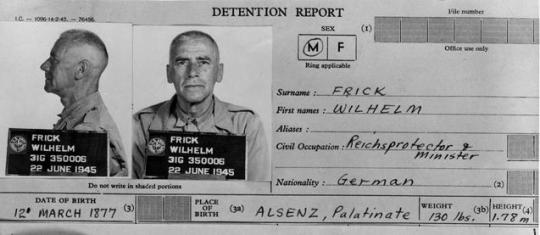
Wilhelm Frick's last words were: "Long live eternal Germany." His time was recorded at 2:20AM. He was aged 69.
8. Julius Streicher

Julius Stretcher's execution was described as melodramatic, and cried out "Heil Hitler" and "The Bolsheviks will hang you one day" before the hood was placed over his head. Julius Streicher's last words were: "Adele, my dear wife." His time of death is unknown. He was aged 61.
9. Fritz Sauckel

(Couldn't find his detention report either, so have this image instead.)
Fritz Sauckel's sentence was considered controversial, considering this his superior, Albert Speer, was sentenced to 20 years imprisonment - just barely avoiding the hangman's noose. His last words were: "I am dying innocent. The sentence is wrong. God protect Germany and make Germany great again. Long live Germany. God protect my family." His time of death was recorded at 2:40AM. He was aged 51.
10. Alfred Jodl
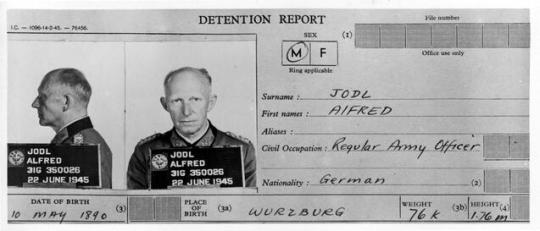
Alfred Jodl's last words were: "I greet you, my eternal Germany." His time of death was recorded at 2:50AM. He was aged 56.
11. Arthur Seyss-Inquart

Arthur Seyss-Inquart's last words were: "I hope this execution is the last act of the tragedy of the Second World War and that the lesson taken from this world war will be that peace and understanding should exist between people. I believe in Germany." His time of death was recorded at 2:59AM. He was aged 54.
The executions were botched. Many of the condemned had slowly strangled to death (such as Joachim von Ribbentrop), and many had hit their heads on the trapdoor as they went down as the trapdoor was too small. One of the condemned took 28 minutes to die.
After the executions, the bodies were taken to a crematorium in Munich (all under false names) and their ashes scattered in the river Isar. The majority of the condemned's war medals were either destroyed or denazified before being handed over to the US finance director for sale to offset the cost of the executions.
30 notes
·
View notes
Text

7 May 1945: Germany surrenders unconditionally, ending the European theater of WWII. The Soviets made them sign on May 8. The surrender is signed at the Western Allied Headquarters in Reims, France at 2:41 am. General Alfred Jodl signs for Germany.
source - https://twitter.com/URDailyHistory
4 notes
·
View notes
Text
In December 1941, the Fuhrer arrived in occupied Mariupol. Many historians and contemporaries, such as the German General Alfred Jodl, claimed that it was here that Hitler first realized that the war was lost.
And so Mariupol local historians tell about H!tler's arrival: "No exquisite dishes for a chic banquet were organized in Mariupol, since the arrival was sudden, late, and the tense situation that developed at the front did not have it."

24 notes
·
View notes
Text
Hoy 8 de mayo se celebra el aniversario del final de la Segunda Guerra Mundial, El Día de la Victoria de Europa. Conflicto que empezó el 1 de septiembre del 1939 con la invasión alemana a territorio polaco. Y que detonó una guerra sin precedentes que enfrentó a dos bandos, las potencias del eje y a los aliados, dejando 46 millones de muertes entre 1939 y 1945.
Las potencias del Eje las conformaban el grupo conocido por el acrónimo “Roberto”, por sus capitales, Roma, Berlín y Tokio. Estás tres potencias tenían el afán de expandir sus territorios y poder. Mientras que el bando de los Aliados, lo conformaban al principio Francia, Polonia y Reino Unido junto a Irlanda del Norte. Otros países se fueron incorporando poco a poco, cuando veían los avances de las potencias del Eje, mientras que EEUU 1941 entro en guerra con Japón, tras el ataque de la base de Pearl Harbor.
En realidad la Segunda Guerra Mundial no acabó el 8 de mayo de 1945, sino que acabo el 14 de agosto del mismo año con la rendición de Japón. Tras la masacre de las bombas atómicas lanzadas por dos B-52 a Hiroshima y Nagasaki los días 6 y 8 de agosto respectivamente.
Lo que celebramos el día 8 es la rendición de Alemania, que realmente supuso la liberación de Europa. Aunque este día ha sido motivo de discusión en el pasado como hoy en día.
El principio del fin de la Segunda Guerra Mundial en Europa
La rendición de una Alemania absolutamente destruida, se empezó a fraguar el 4 de febrero de 1945 en la conferencia de Yalta. Llevada a cabo entre los líderes, de las tres grandes potencias aliadas. Winston Churchill, Joseph Stalin y Franklin Delano Roosevelt, por Reino Unido, la Unión Soviética y Estados Unidos, respectivamente.
Donde se planeó la derrota final del régimen nazi y el ensañamiento contra una Alemania destrozada. Como fueron los bombardeos del 13 de febrero de 1945 de la ciudad alemana de Dresden por aviones británicos que destruyeron la ciudad y dejaron 25.000 víctimas. O la ocupación de Alemania que se repartieron entre las tres potencias. Rencillas que llevaron finalmente entre otras cosas a no ponerse de acuerdo del día de la rendición del ejército nazi. Del día del aniversario del final de la Segunda Guerra Mundial.
Además de ser el germen para lo que luego se llamó la Guerra Fría, entre los países capitalistas y los países comunistas.
Alemania se rindió el 7, el 8 o el 9 de mayo
El 30 de abril de 1945 Adolf Hitler y su esposa Eva Braun en su búnker debajo de la Cancillería de Berlín se suicidaron. Hitler había nombrado al almirante naval Karl Dönitz su sucesor en caso de muerte. Quien delego el cargo en el jefe de mando de operaciones de las Wehrmacht Alfred Jodl.
Alfred Jodl tenía que negociar la rendición de todas las fuerzas alemanas con el general D. Eisenhower. Mientras Dönitz quería ganar tiempo en las negociaciones para salvar a todos los soldados y civiles alemanes de los rusos. Además intentar convencer a los Aliados de que la Unión Soviética no iba a cumplir sus acuerdos. Sin embargo Eisenhower no cayó en la trampa e insistió en que Alfred Jodl firmara un acta de capitulación sin negociaciones.
Las tropas británicas entraron en Cuxhaven a las 14:00 del 6 de mayo. A partir de ahora toda la transmisión de radio cesará. Los mejores deseos a todos...Cerrando para siempre -los mejores deseos- adiós".últimas interceptaciones hechas del ejército alemán por los decodificadores de Bletchley Park, antes de la rendición.
Motivo por el que el 7 de mayo Alfred Jodl se vio obligado a firmar el acta de capitulación militar incondicional y un alto el fuego en Reims. Esta capitulación del ejército alemán tenía que entrar en vigor a las 23:01 el 8 de mayo.
https://www.youtube.com/watch?v=N6pw027Kxww
7 de mayo de 1945, Alfred Jodl firmó el acta de capitulación militar incondicional
Joseph Stalin enojando con esta rendición a sus espaldas exigió que se refrendara en el cuartel general soviético en Karlshorst, Berlín. Y el 8 de mayo de 1945, a las 23:01, se produjo la segunda capitulación del ejército alemán.
Ya con el mariscal soviético Georgy Zhukov., el jefe de las fuerzas armadas alemanas, el mariscal Wilhelm Keitel, firmó nuevamente la rendición con unas horas de retraso que llevaron hasta el día 9 de mayo. Keitel quería negociar unas horas de gracia para sus soldados y ciudadanos, pero no consiguió modificar el documento.
Mientras tanto en Checoslovaquia, desde el día 5 de mayo se produjo el levantamiento del pueblo checo contra el régimen nazi. Deshaciéndose de los alemanes pero sin saber que llegaría otro periodo de opresión con el régimen soviético.
Dudas que quedarán durante mucho tiempo.
Siempre quedaran dudas y llegaran especulaciones. Pero entre las mayores incógnitas estará sobre la realidad de que pasó con Adolf Hitler, si se suicidó o no. Hay teorías que dicen que escapó a Argentina.
En el caso de los checos, con respecto a los bombardeos de Praga por parte de los americanos, siempre quedará la duda si realmente fue un error.
0 notes
Text
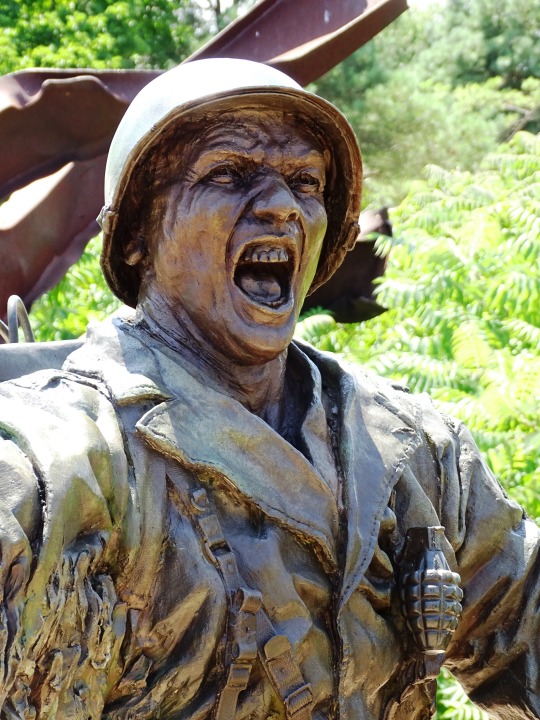
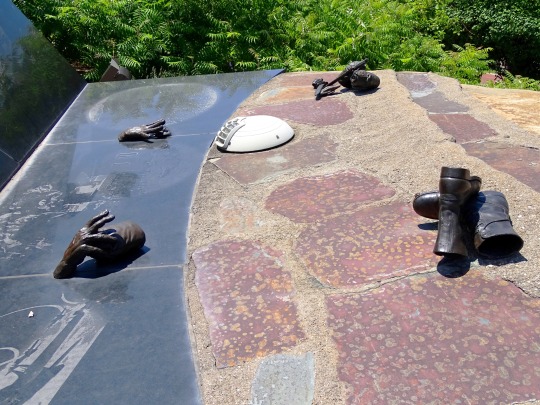
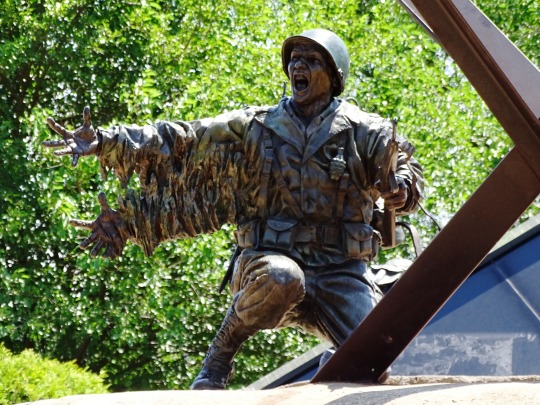
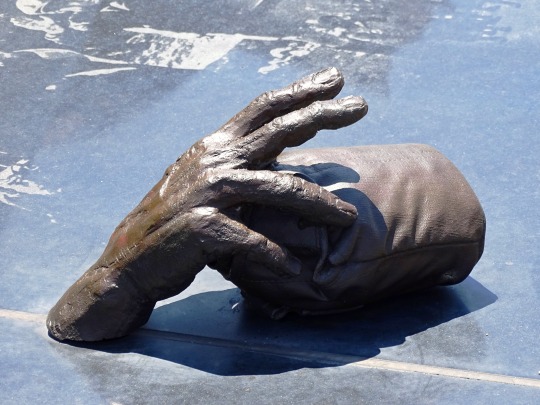
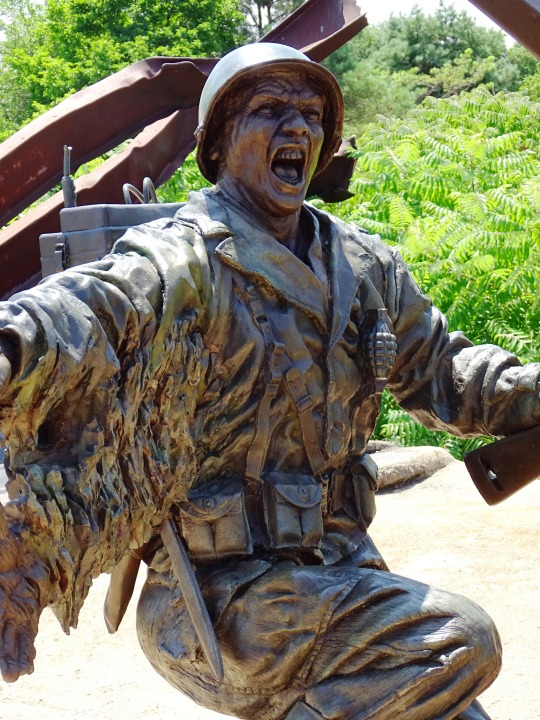
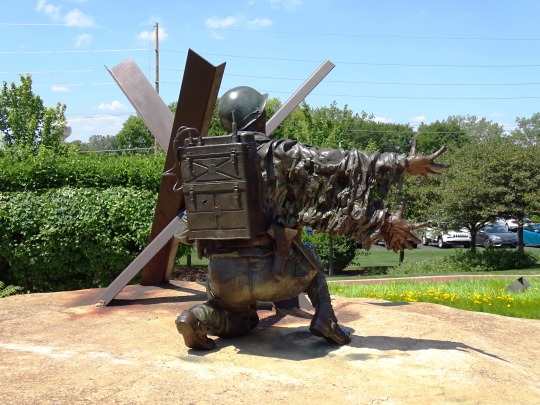


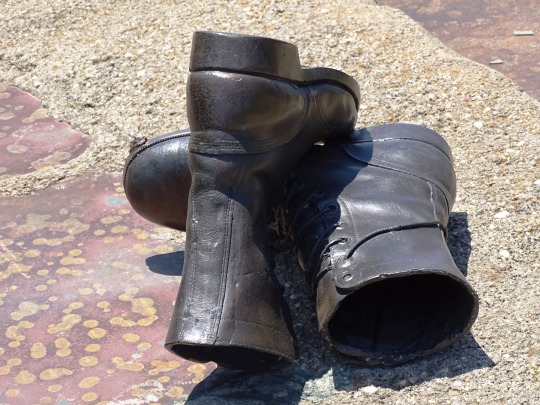

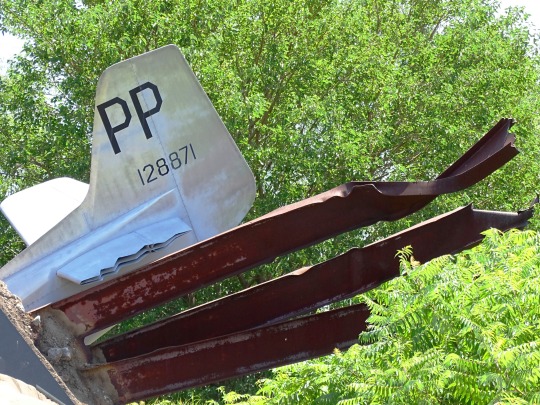
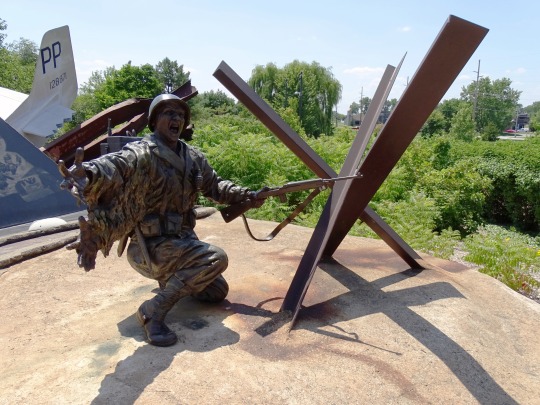
Victory in Europe Day
Victory in Europe Day is observed on May 8 to commemorate when the Allies of World War II formally accepted Germany’s unconditional surrender of its armed forces. Did you know that even after Germany — the architect of the war — surrendered, Japan continued to wage war against the Allied troops? World War II was the costliest war ever; over 75 million lives were lost, cities leveled, and the economy of Europe was devastated. The war began when Hitler’s Germany invaded Poland and ended nearly six years later when Japan surrendered. Victory in Europe Day is celebrated as a public holiday in several European countries and termed V.E. Day and V-E Day in the U.K. and the U.S., respectively.
HISTORY OF VICTORY IN EUROPE DAY
On April 30, 1945, the Allied forces surrounded Germany, tightening the noose around the German army. Realizing the hopelessness of his situation, Hitler killed his newly wedded wife, Eva Braun, and committed suicide in his Berlin bunker. Immediately taking the presidency, Grand Admiral Karl Donitz, Hitler’s successor, began negotiating for a term of surrender with the Allied forces. Chief among his goals was saving as many Germans as possible from being captured by the Soviets.
On May 4, in Luneburg Heath, British Field Marshal Bernard Montgomery accepted the unconditional surrender of German forces in the Netherlands, northwest Germany, and Denmark. On May 7, another unconditional military surrender was signed at SHAEF H.Q. at Reims, between Supreme Allied Commander General Eisenhower and General Alfred Jodl of Germany. The following day, a slightly modified document — the definitive German Instrument of Surrender — was signed in Karlshorst, Berlin, by German Field Marshal William Keitel.
Following the announcement of the German surrender on radio on May 7, the news quickly spread across the western world, and jubilations erupted everywhere, especially in North America and the U.K. The B.B.C. interrupted their program to announce that Victory in Europe Day would be a national holiday. Over one million people trooped out to the streets of the U.K. to celebrate, while in London, people crowded Trafalgar Square, the Mall, and Buckingham Palace. The British Royal Family, joined by Prime Minister Winston Churchill, appeared on the palace’s balcony, waving to the cheering crowds.
In the United States, Victory in Europe Day happened to be the same day as President Harry Truman’s 61st birthday. However, he dedicated the victory to his late predecessor, Franklin D. Roosevelt and the U.S. flag remained at half-mast. Victory in Europe Day was also celebrated in Australia, Paris, and Canada — where a riot broke down and resulted in several deaths.
VICTORY IN EUROPE DAY TIMELINE
April 30,1945 The Suicide of Hitler
During the Battle of Berlin, the city becomes surrounded — so, Hitler kills his wife and commits suicide.
May 4, 1945 The First Act of Surrender
British Field Marshal Bernard Montgomery accepts the unconditional surrender of German forces in the Netherlands, northwest Germany, and Denmark.
May 7, 1945 The Second Act of Surrender
Supreme Allied Commander General Eisenhower accepts the unconditional surrender of German forces from German General Alfred Jodl.
May 8, 1945The German Instrument of Surrender
The definitive German Instrument of Surrender is signed in Berlin by German Field Marshal William Keitel.
August 14, 1945 The End of the War
Japan agrees to surrender to the Allied forces and formally signs an agreement the following month.
VICTORY IN EUROPE DAY FAQS
Is Victory in Europe Day celebrated in Germany?
Victory in Europe Day is generally viewed in Germany as a day to commemorate those that died during the war. However, it’s also a day to renew their promises of preventing such events from happening again.
Who celebrates Victory in Europe Day?
Victory in Europe Day is mainly celebrated by North American and European countries, including Israel and the European Union — celebrated as Europe Day.
How do the French celebrate Victory in Europe Day?
Victory in Europe Day is celebrated with a lot of festivities and fanfare. Church services, parades, ceremonies, monument visitations, and air force flyovers are ways Victory in Europe Day is commemorated in France.
HOW TO OBSERVE VICTORY IN EUROPE DAY
Visit the World War II Memorial
Talk to a World War II veteran
Watch World War II movies or documentaries
The World War II Memorial was built in 2004 to honor those that fought and died during World War II. The memorial is located in Washington D.C. You can visit and take a tour around this place of honor to pay your respects to those that prevented the war from entering our borders.
You can observe Victory in Europe Day by chatting with a WWII veteran about the unfiltered events of the war. There are many of these veterans around, and they can be found at senior homes. Visiting them would allow you to learn a lot and provide you with an opportunity to appreciate them for their sacrifices.
Many films are produced almost every decade, dedicated to the major battles of World War II. You can spend Victory in Europe Day by watching classics like “Stalingrad,” “Dunkirk,” “Dirty Dozen,” “Come and See,” and “Saving Private Ryan.” You can also watch documentaries, such as “Battlefield,” “World At Watt,” and “Russia’s War: Blood Upon the Snow.”
5 IMPORTANT FACTS ABOUT WORLD WAR II
It was between two groups of countries
The Holocaust happened
Some countries remained neutral
It was the bloodiest war
Millions died for not being perfect Germans
World War II was fought between Allied countries — Britain, France, Russia, China, and the U.S. — and Axis nations — Germany, Italy, and Japan.
Hitler’s Germany killed about six million Jewish people during the war.
Spain, Sweden, and Switzerland are examples of countries that never chose a side during the war.
About 75 million people died during the war, including 40 million civilians and 20 million military personnel.
Aside from Jews, Hitler ordered people with disabilities and Gypsies to be killed for not meeting his vision of the best and strongest race.
WHY VICTORY IN EUROPE DAY IS IMPORTANT
It marked the beginning of the end of WWII
It serves as a day of remembrance
It’s a day of reflection
When the German forces surrendered to the Allied troops on Victory in Europe Day, it ended the war on the European theatre, allowing the Allies to concentrate their efforts to win in the Eastern theatre three months later.
Victory in Europe Day is not only a day to celebrate Germany’s surrender but also a day to appreciate the military personnel that fought and died to make it happen.
Victory in Europe Day is a day for every country that participated in World War II, both the instigators and heroes, to reflect on the actions and events that led to the outbreak of war and ensure they don’t repeat themselves.
Source
#lone infantryman on Omaha Beach#Community Veterans Memorial#Indiana#USA#Munster#very impressive#free admission#Omri Amrany#8 May 1945#Victory in Europe Day#European history#V-E Day#VictoryInEuropeDay#WWII#World War Two#World War II#Pacific Monument#Europe Monument#Midwestern USA#Great Lakes Region#original photography#summer 2019#tourist attraction#landmark#travel#vacation#cityscape#anniversary#history
1 note
·
View note
Text
GERMAN FORCES SURRENDERED AT REIMS, FRANCE
On May 7, 1945, the German High Command, represented by General Alfred Jodl, signed the unconditional surrender of all German forces at Reims, France. This momentous event marked the end of World War II in Europe and brought about the defeat of Nazi Germany.eneral Jodl initially attempted to negotiate terms that would only apply to the German forces fighting against the Western Allies. However,…

View On WordPress
0 notes
Text
History
May 7, 1915 - The British passenger ship Lusitania was torpedoed by a German submarine off the coast of Ireland, losing 1,198 of its 1,924 passengers, including 114 Americans. The attack hastened neutral America's entry into World War I.
May 7, 1945 - In a small red brick schoolhouse in Reims, Germany, General Alfred Jodl signed the unconditional surrender of all German fighting forces thus ending World War II in Europe. Russian, American, British and French ranking officers observed the signing of the document which became effective at one minute past midnight on May 9th. Jodl was then ushered in to see Supreme Allied Commander, General Dwight D. Eisenhower, who curtly asked Jodl if he fully understood the document. Eisenhower then informed Jodl that he would be held personally responsible for any deviation from the terms of the surrender. Jodl was then ushered away.
May 7, 1954 - The French Indochina War ended with the fall of Dien Bien Phu, in a stunning victory by the Vietnamese over French colonial forces in northern Vietnam. The country was then in divided in half at the 17th parallel, with South Vietnam created in 1955.
May 7, 1992 - The 27th Amendment to the U.S. Constitution was ratified, prohibiting Congress from giving itself pay raises.
Birthday - Composer Johannes Brahms (1833-1897) was born in Hamburg, Germany. He composed over 300 songs and numerous orchestral, choral, piano, and chamber works, including his German Requiem commemorating the death of his mother.
Birthday - American poet Archibald MacLeish (1892-1982) was born in Glencoe, Illinois. He was awarded three Pulitzer Prizes, and was also a playwright, editor, lawyer, professor, farmer, and served as Librarian of Congress from 1939 to 1944.
0 notes
Photo

Hitler with his staff at headquarters In June 1940, Hitler and his entourage were photographed at the Führer's headquarters. As far as is known, from left to right: SA Obergruppenfuhrer Wilhelm Brückner, OKH Adjutant Major Engel, Reich Press Chief Dr. Otto Dietrich, Hitler's doctor, Dr. Karl Brandt, Chief of the OKW Colonel-General Wilhelm Keitel, Luftwaffe Adjutant Major General [Karl] Bodenschatz, Adolf Hitler, Wehrmacht Adjutant Colonel Rudolf Schmundt, SS Adjutant SS-Group Leader Julius Schaub, Chief of the Wehrmacht Command Office in the OKW General Alfred Jodl, Adjutant Himmler and liaison to Hitler's SS -Group leader Karl Wolff, head of the party chancellery Reichsleiter Martin Bormann, Hitler's personal physician Prof. Dr. [Theo] Morell, Air Force Adjutant Captain von Below, Reich Photographer of the NSDAP Heinrich Hoffmann. The “Wolfsschanze”, a name coined by Hitler, was near the town of Ketrzyn, Warmińsko-Mazurskie Voivodeship (formerly Rastenburg, Allenstein District), Republic of Poland.
1 note
·
View note
Quote
Up to the year 1939 we were, of course, in a position to destroy Poland alone. But we were never, either in 1938 or 1939, actually in a position to withstand a concentrated attack by these states together. And if we did not collapse already in the year 1939, that was due only to the fact that during the Polish campaign, the approximately 110 French and British divisions in the west were held completely inactive against the 23 German divisions.
General Alfred Jodl (speaking about British and French inaction during the invasion of Poland in 1939)
0 notes
